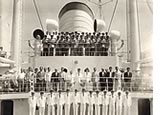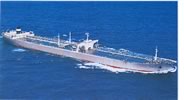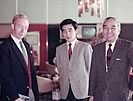- Home
- Company Profile
- Historical Background
- History
- 1950-1984
1950-1984
- 1950-1956
Active reconstruction - 1956-1964
New developments - 1964-1967
Reorganization and mergers - 1967-1972
Rapid advance of business - 1972-1974
Turning point to depression - 1974-1978
Pressure of structural recession - 1978-1984
Stability through reduction
1950-1956 Active reconstruction

The contract with Tonen K.K. became the base of the company's long-term chartering business, which strategically focused on large specialized vessels in later years. The liner service ship M/S Meirinsan Maru was built during the ninth shipbuilding program in 1954, followed by a sister liner ship M/S Meikei Maru by the 10th program in 1955.
Meikai Building, which had been requisitioned by the Occupation forces, was returned in 1952. After remodeling, it was re-inaugurated the same year and has been leased as office space since.
1956-1964 New developments

In July 1956, the first large freight ship, M/S Meitetsu Maru, was assigned by the 11th shipbuilding program, and the company's first self-financed vessel, M/S Meiryu Maru, was completed in December of the same year. In the following five years, eight new ships were built. The market experienced an unexpected slump when the Suez Canal was reopened in April 1957, and the industry was forced to alter its structure to survive the depression. Quickly responding to this situation, Meiji Shipping radically modified its tonnage expansion plans and management principles. The configuration of the fleet was greatly restructured.
High-efficiency freight ships, for instance, were chartered in long-term contracts to respond to the long-term ship distribution perspectives of Mitsui Line Ltd. A large tanker was built to meet Tonen K.K.'s crude oil transport plan. Thanks to such efforts, the company grew to own 13 ships with a total deadweight of 212,349 tons.
Meanwhile, the firm's capital increased to JPY1,800,000,000 by October 1956. The expansion of the new wing of Meikai Building was completed in July 1957 to become an eight-story concrete and steel structure with two other floors underground. This brought the total floor space of the complex to 12,653 square meters.
1964-1967 Reorganization and mergers
In July 1963, legislation for reorganizing maritime industry was revamped, aiming to restructure the shipping industry mired in a business slump. Ninety-five companies that owned 90 percent of Japan's tonnage on international routes, were regrouped under six major organizations as affiliated or exclusively contracted companies.
Meiji Shipping joined the Mitsui O.S.K. group as an exclusively contracted sea carrier.
Reorganization progressed smoothly, and the under-depreciation was cleared by the end of September 1966, sooner than originally planned.
The arrears were also cleared in October of the same year, and thus the company's management foundation became considerably solid. In April 1964, a related company, Meikai Kosan K.K., was established to engage in real estate administration and marine insurance and equipment purchasing mainly for ships. In August of the same year, the Meikai Building Annex was built and the company's head office was moved there.
1967-1972 Rapid advance of business

Many aggressive measures were taken, and dividend payments were resumed to reach the rate of 6 percent per year in September 1967, making Meiji the first shipping company to do so at the time.
In August, the 150,000-ton class tanker T/S Meisen Maru, the largest assignment in the history of the company and the government's shipbuilding programs, was built for Tonen K.K. In December, Meiji Shipping took charge of managing General Shipping Co., Ltd.'s newly built tanker M/S Goko Maru. In April 1968, Meikai Oil Service was established as a related company. In 1970, the fiscal term was set as a one year period starting April 1.
In August 1970, the 230,000-ton class tanker T/S Meigen Maru, assigned by the 25th shipping program, was built in order to meet the demands for very large crude carriers with low operation costs.
While replacing old cargo ships, new ships with higher marketability were built. High-efficiency tankers and specialized vessels were strengthened, including M/S Meiko Maru and M/S Meiryu Maru for carrying cars and bulk cargo, and the M/S Mori Maru for transporting wood chips.
1972-1974 Turning point to depression

Under such critical circumstances, the company streamlined management, and dividends had to be suspended once. Yet the company was not totally free from stagnation, and the slump affect gradually intensified.
1974-1978 Pressure of structural recession
The first oil crisis in 1973, followed by a long recession, caused a decrease in maritime trade and over supply in oil tanker tonnage throughout the world. This led the Japanese shipping industry to plunge into sudden recurring losses in 1975.
Moreover, weakness in international competition because of a sharp increase in labor costs, weakness against recession and market participation by countries with newly developed shipping industries, such as Greece, Hong Kong, Taiwan and Korea threatened many companies with bankruptcy.
In August, 1974, however, the company completed T/S Meitai Maru, assigned by the 29th shipbuilding program, in a new-style contract to share ownership with Tonen K.K. The ships losing international competitiveness were sold to foreign countries to secure efficiency and survive the recession.
Responding to the internationalization of the Japanese economy, the company established joint ventures with local firms aiming at foreign markets.
A number of new vessels such as medium-sized tankers, pure car carriers, bulk carriers and chip carriers have been continuously built and chartered or operated by the company. The ongoing recession was to be overcome through various administrative efforts to diversify business.
Under such principles, International Marine Consultant Inc. was jointly established with Mitsui & Co., Ltd. on July 1st, 1974, to manage ship operations including supervision and inspection of new and/or existing ships mainly for foreign clients. In April 1977, in order to survive the critical economic situation, the Tokyo Headquarters was established, and the functions of the company headquarters were transferred there.
1978-1984 Stability through reduction

In April 1981, the PCC M/S Meiyo Maru, and in September 1983, another PCC, the M/S Meiho Maru, were built, both with the company's self-financing management.

